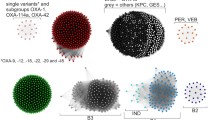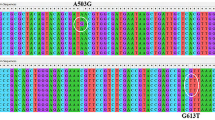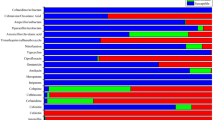Abstract
Carbapenemase-mediated carbapenem resistance is a major public health concerns worldwide. In the present study, prevalence of circulating carbapenemases was estimated among carbapenem-resistant clinical isolates using PCR and sequencing. Diameters of zone of inhibition (ZDs) were compared for imipenem, meropenem and ertapenem among single carbapenemase producing isolates. Structure-based functional fitness of those carbapenemases was predicted through several in silico analyses. Approximately, 63.76% isolates demonstrated carbapenem resistance, of which 39.13% harboured carbapenemases like blaNDM-1 (33.23%), blaNDM-1-like (0.31%), blaVIM-2 (4.35%), blaKPC-2 (4.04%), blaOXA-181 (6.85%), blaOXA-23 (16.50%), blaOXA-69 (3.88%), blaOXA-66 (2.91%) and blaOXA-104 (1.94%). Omega values indicated selection pressure over blaOXA-69, blaOXA-66 and blaOXA-104. Protein structural dynamics predicted NDM-1 and KPC-2 to have the highest and least flexibility, indicating differences in β-lactam binding and catalytic efficiency. Increased requirement of free folding energy, improved solvent accessibility and decreased melting temperatures among NDM-1-like, OXA-181, OXA-66, OXA-69 and OXA-104 predicted functional improvement over their ancestral variants. NDM-1-like carbapenemases demonstrated improvement in binding stability, affinity and catalysis of meropenem than that of NDM-1. Catalytic activity of imipenem was predicted to improve among OXA-181, which could be correlated with more than 1.5 folds smaller ZDs around imipenem disc, than that of meropenem/ertapenem, among OXA-181 producing isolates. However, OXA-66 indicated greater binding stability and affinity for imipenem and meropenem. This study indicated structural/functional convergence as well as divergence among several carbapenemase variants and provided useful insights into carbapenemase-mediated carbapenem resistance that might help in identifying appropriate treatment regimen for bacterial infections.




Similar content being viewed by others
References
Chou PY, Fasman GD (1978) Empirical predictions of protein conformation. Annu Rev Biochem 47:251–276. https://doi.org/10.1146/annurev.bi.47.070178.001343
Clinical and Laboratory Standards Institute (2014) Performance standards for antimicrobial susceptibility testing: approved standard M100–S24, 27th edn. Clinical and Laboratory Standards Institute, Wayne
Dehouck Y, Kwasigroch JM, Gilis D, Rooman M (2011) PoPMuSiC 2.1: a web server for the estimation of protein stability changes upon mutation and sequence optimality. BMC Bioinform 12:151. https://doi.org/10.1186/1471-2105-12-151
Dhara L, Tripathi A (2014) Genetic and structural insights into plasmid-mediated extended-spectrum β-lactamase activity of CTX-M and SHV variants among pathogenic Enterobacteriaceae infecting Indian patients. Int J Antimicrob Agents 43(6):518–526. https://doi.org/10.1016/j.ijantimicag.2014.03.002
Fiser A, Sali A (2003) ModLoop: automated modeling of loops in protein structures. Bioinformatics 19(18):2500–2501. https://doi.org/10.1093/bioinformatics/btg362
Fröhlich C, Sørum V, Thomassen AM, Johnsen PJ, Leiros HS, Samuelsen Ø (2019) OXA-48-mediated ceftazidime-avibactam resistance is associated with evolutionary trade-offs. mSphere 4(2):e00024–e19. https://doi.org/10.1128/mSphere.00024-19
Galdadas I, Lovera S, Pérez-Hernández G, Barnes MD, Healy J, Afsharikho H, Woodford N, Bonomo RA, Gervasio FL, Haider S (2018) Defining the architecture of KPC-2 Carbapenemase: identifying allosteric networks to fight antibiotics resistance. Sci Rep 8(1):12916. https://doi.org/10.1038/s41598-018-31176-0
Galleni M, Lamotte-Brasseur J, Rossolini GM, Spencer J, Dideberg O, Frère JM (2001) Standard numbering scheme for class B beta-lactamases. Antimicrob Agents Chemother 45(3):660–663. https://doi.org/10.1128/AAC.45.3.660-663.2001
Guo Y, Wang J, Niu G, Shui W, Sun Y, Zhou H, Zhang Y, Yang C, Lou Z, Rao Z (2011) A structural view of the antibiotic degradation enzyme NDM-1 from a superbug. Protein Cell 2(5):384–394. https://doi.org/10.1007/s13238-011-1055-9
Li H, Chang YY, Lee JY, Bahar I, Yang LW (2017) DynOmics: dynamics of structural proteome and beyond. Nucleic Acids Res 45(W1):W374–W380. https://doi.org/10.1093/nar/gkx385
Mariappan S, Sekar U, Kamalanathan A (2017) Carbapenemase-producing enterobacteriaceae: risk factors for infection and impact of resistance on outcomes. Int J Appl Basic Med Res 7(1):32–39. https://doi.org/10.4103/2229-516X.198520
Martínez-García L, González-Alba JM, Baquero F, Cantón R, Galán JC (2018) Ceftazidime is the key diversification and selection driver of VIM-type carbapenemases. MBio 9(3):e02109–e2117. https://doi.org/10.1128/mBio.02109-17
Mehta SC, Rice K, Palzkill T (2015) Natural variants of the KPC-2 carbapenemase have evolved increased catalytic efficiency for ceftazidime hydrolysis at the cost of enzyme stability. PLoS Pathog 11(6):e1004949. https://doi.org/10.1371/journal.ppat.1004949
Meini MR, Llarrull LI, Vila AJ (2014) Evolution of Metallo-β-lactamases: trends revealed by natural diversity and in vitro evolution. Antibiotics (Basel) 3(3):285–316. https://doi.org/10.3390/antibiotics3030285
Morris GM, Huey R, Lindstrom W, Sanner MF, Belew RK, Goodsell DS, Olson AJ (2009) AutoDock4 and AutoDockTools4: Automated docking with selective receptor flexibility. J Comput Chem 30(16):2785–2791. https://doi.org/10.1002/jcc.21256
Naas T, Dortet L, Iorga BI (2016) Structural and functional aspects of class A carbapenemases. Curr Drug Targets 17(9):1006–1028. https://doi.org/10.2174/1389450117666160310144501
Nordmann P, Poirel L (2014) The difficult-to-control spread of carbapenemase producers among Enterobacteriaceae worldwide. Clin Microbiol Infect 20(9):821–830. https://doi.org/10.1111/1469-0691.12719
Pal A, Dhara L, Tripathi A (2019) Contribution of acrB upregulation & OmpC/Ompk36 loss over the presence of blaNDM towards carbapenem resistance development among pathogenic Escherichia coli & Klebsiella spp. Indian J Med Res 149(4):528–538. https://doi.org/10.4103/ijmr.IJMR_716_17
Palzkill T (2018) Structural and mechanistic basis for extended-spectrum drug-resistance mutations in altering the specificity of TEM, CTX-M, and KPC β-lactamases. Front Mol Biosci 5:16. https://doi.org/10.3389/fmolb.2018.00016
Poirel L, Naas T, Nordmann P (2010) Diversity, epidemiology, and genetics of class D beta-lactamases. Antimicrob Agents Chemother 54(1):24–38. https://doi.org/10.1128/AAC.01512-08
Pucci F, Bourgeas R, Rooman M (2016) Predicting protein thermal stability changes upon point mutations using statistical potentials: Introducing HoTMuSiC. Sci Rep 6:23257. https://doi.org/10.1038/srep23257
Queenan AM, Bush K (2007) Carbapenemases: the versatile beta-lactamases. Clin Microbiol Rev 20(3):440–458. https://doi.org/10.1128/CMR.00001-07
Sali A, Blundell TL (1993) Comparative protein modelling by satisfaction of spatial restraints. J Mol Biol 234(3):779–815. https://doi.org/10.1006/jmbi.1993.1626
Schroder EC, Klamer ZL, Saral A, Sugg KA, June CM, Wymore T, Szarecka A, Leonard DA (2016) Clinical variants of the native Class D β-Lactamase of Acinetobacter baumannii pose an emerging threat through increased hydrolytic activity against carbapenems. Antimicrob Agents Chemother 60(10):6155–6164. https://doi.org/10.1128/AAC.01277-16
Simonetti FL, Teppa E, Chernomoretz A, Nielsen M, Marino Buslje C (2013) MISTIC: mutual information server to infer coevolution. Nucleic Acids Res. https://doi.org/10.1093/nar/gkt427
Skagseth S, Carlsen TJ, Bjerga GEK, Spencer J, Samuelsen Ø, Leiros HKS (2016) Role of residues W228 and Y233 in the structure and activity of Metallo-β-lactamase GIM-1. Antimicrob Agents Chemother 60(2):990–1002. https://doi.org/10.1128/AAC.02017-15
Smith CA, Antunes NT, Stewart NK, Toth M, Kumarasiri M, Chang M, Mobashery S, Vakulenko SB (2013) Structural basis for carbapenemase activity of the OXA-23 β-lactamase from Acinetobacter baumannii. Chem Biol 20(9):1107–1115. https://doi.org/10.1016/j.chembiol.2013.07.015
Smith CA, Antunes NT, Stewart NK, Frase H, Toth M, Kantardjieff KA, Vakulenko S (2015) Structural basis for enhancement of carbapenemase activity in the OXA-51 family of Class D β-Lactamases. ACS Chem Biol 10(8):1791–1796. https://doi.org/10.1021/acschembio.5b00090
Stierand K, Maass PC, Rarey M (2006) Molecular complexes at a glance: automated generation of two-dimensional complex diagrams. Bioinformatics 22(14):1710–1716. https://doi.org/10.1093/bioinformatics/btl150
Tamura K, Peterson D, Peterson N, Stecher G, Nei M, Kumar S (2011) MEGA5: molecular evolutionary genetics analysis using maximum likelihood, evolutionary distance, and maximum parsimony methods. Mol Biol Evol 28(10):2731–2739. https://doi.org/10.1093/molbev/msr121
Volkamer A, Kuhn D, Grombacher T, Rippmann F, Rarey M (2012) Combining global and local measures for structure-based druggability predictions. J Chem Inf Model 52(2):360–372. https://doi.org/10.1021/ci200454v
Walia K, Madhumathi J, Veeraraghavan B, Chakrabarti A, Kapil A, Ray P, Singh H, Sistla S, Ohri VC (2019) Establishing antimicrobial resistance surveillance & research network in India: journey so far. Indian J Med Res 149(2):164–179. https://doi.org/10.4103/ijmr.IJMR_226_18
Walther-Rasmussen J, Høiby N (2006) OXA-type carbapenemases. J Antimicrob Chemother 57(3):373–383. https://doi.org/10.1093/jac/dki482
Acknowledgements
Authors are extremely grateful to Director, Calcutta School of Tropical Medicine, India for support, constant inspiration and providing necessary facilities for the study.
Funding
Authors gratefully acknowledge Indian Council of Medical Research for providing financial support to the first author [no. 3/1/3/WL/JRF-2011/HRD-129 (41937)].
Author information
Authors and Affiliations
Contributions
AP and AT conceived and designed research. They analyzed data. IB provided clinical isolates. AP conducted experiments and wrote the manuscript. AT proof read the manuscript. All authors read and approved the manuscript.
Corresponding author
Ethics declarations
Conflict of interest
The authors declare that they have no conflict of interest.
Ethical approval
All the isolates used in this study were collected following guidelines of Institutional Clinical Research Ethics Committee (Ref. No. CREC-STM/260 dated 9/1/2013).
Consent to participate
Clinical isolates were collected after having written consent from patients willing to participate.
Additional information
Publisher's Note
Springer Nature remains neutral with regard to jurisdictional claims in published maps and institutional affiliations.
Electronic supplementary material
Below is the link to the electronic supplementary material.
Rights and permissions
About this article
Cite this article
Pal, A., Bhattacharyya, I. & Tripathi, A. Structure-based functional fitness analyses of carbapenemase variants identified among pathogenic carbapenem-resistant Gram-negative bacteria. World J Microbiol Biotechnol 36, 129 (2020). https://doi.org/10.1007/s11274-020-02905-3
Received:
Accepted:
Published:
DOI: https://doi.org/10.1007/s11274-020-02905-3




